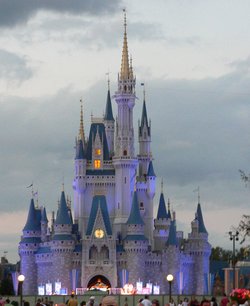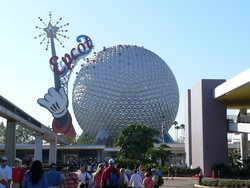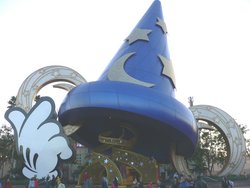Walt Disney World Resort
|
|
WDW_Logo.jpg

WDW_Tree_of_Life.jpg
Owned and operated by The Walt Disney Company, Walt Disney World Resort is home to four theme parks, two water parks, six golf courses, more than twenty resort hotels, and various shopping and entertainment areas in Orange and Osceola Counties, Florida, USA . Most of the Walt Disney Company's Central Florida land, and all of the public areas, are located in the Cities of Bay Lake and Lake Buena Vista, which are both contained in the Reedy Creek Improvement District. These governmental entities, controlled by the Walt Disney Company, are located southwest of Orlando and a few miles northwest of Kissimmee. The Walt Disney World Resort opened on October 1, 1971. It is the largest theme park resort in the world, although Dubai Land, twice its size, is planned to open in 2006.
| Contents |
Concept
Walt Disney's concept for Disney World was of a larger, more expansive version of Disneyland, so that it could constantly expand and not be as constrained by the need for land that Disneyland suffered from. Walt Disney World also was to be a sort of "Disneyland of the future" where breakthroughs in science and technology could coexist with the original Disney vision of themed entertainment.
Walt Disney also envisioned this project as incorporating a working community where his ideas about urban planning could be tested. He called this concept the "Experimental Prototype Community (or City) of Tomorrow," or EPCOT. Cast Members say that EPCOT stands for Every Person Comes Out Tired. The theme park that eventually opened under the Epcot name bore little resemblance to this vision, though the neighboring planned community of Celebration, which was founded by the Walt Disney Company, incorporates a few of the ideas.
Although he participated in much of the planning for the project, Walt Disney himself died in 1966 and never got to see the realization of his vision. The resort was originally to be named "Disney World," but before its opening Walt's brother Roy renamed it to "Walt Disney World" in his honor.
The land within Walt Disney World is part of the Reedy Creek Improvement District which allows the Disney Corporation to exercise quasi-governmental powers over the area.
Properties
Walt Disney World Resort features four major theme parks, each with a main attraction that serves as its symbol:
- The Magic Kingdom (Cinderella Castle)
- Epcot (Spaceship Earth, the giant golf ball-looking geodesic sphere)
- Disney-MGM Studios (the giant Mickey sorcerer's cap, though formerly the 'Earful Tower' water tower represented it)
- Disney's Animal Kingdom (the Tree of Life)
There are also two water parks, Typhoon Lagoon and Blizzard Beach. (A third, River Country, has been closed indefinitely.)
The Downtown Disney area contains many shopping, dining, and entertainment venues, including DisneyQuest (a "virtual theme park" inside a building), and a permanent Cirque du Soleil show (La Nouba).
Another notable aspect is the large number of hotel resort complexes on the Walt Disney World property. The non-themed hotels are owned by private, non-Disney hospitality companies such as Marriott and Hilton. The themed resorts include:
- Disney's All-Star Movies Resort
- Disney's All-Star Music Resort
- Disney's All-Star Sports Resort
- Disney's Animal Kingdom Lodge
- Disney's Beach Club Resort
- Disney's Beach Club Villas
- Disney's BoardWalk Inn
- Disney's BoardWalk Villas
- Disney's Caribbean Beach Resort
- Disney's Contemporary Resort
- Disney's Coronado Springs Resort
- Disney's Fort Wilderness Resort & Campground
- Disney's Grand Floridian Resort and Spa
- Disney's Old Key West Resort
- Disney's Polynesian Resort
- Disney's Pop Century Resort
- Disney's Port Orleans Resort Riverside (formerly named Dixie Landings)
- Disney's Port Orleans Resort French Quarter
- Disney's Saratoga Springs Resort & Spa (formerly the Disney Institute)
- Disney's Wilderness Lodge
- Disney's Yacht Club Resort
- Shades of Green (named because of its location between two golf courses; it's currently leased by the United States Department of Defense and used for vacationing active and retired military personnel and their families)
- The Villas at Disney's Wilderness Lodge
- Walt Disney World Dolphin (operated by Starwood)
- Walt Disney World Swan (operated by Starwood)
The Walt Disney World resort also includes five world-class golf courses. The five 18-hole golf courses are the Magnolia, the Palm, Lake Buena Vista, Eagle Pines, and Osprey Ridge (the last two are part of the Bonnet Creek Golf Club). There are two miniature golf courses: Fantasia Gardens and Winter Summerland.
Walt Disney World paved the way for many other theme parks and attractions in the area, including SeaWorld and Universal Studios, and helped make Orlando a popular tourist destination for people from all over the world.
When the Magic Kingdom opened in 1971, the Walt Disney World Resort employed about 5,500 cast members. Today it employs more than 57,000 cast members, spending more than $1.1 billion on payroll and $478 million on benefits each year. The largest single-site employer in the United States, Walt Disney World Resort has more than three thousand job classifications.
The Walt Disney World Resort also sponsors and operates the Walt Disney World College Program, an internship program that has US college students live in Orlando and work for Walt Disney World, providing much of the theme park and resort "front line" cast members.
In a March 30, 2004 article in the Orlando Sentinel, Walt Disney World president Al Weiss gave some insight into how the parks are maintained:
- More than 5,000 cast members are dedicated to maintenance and engineering, including 650 horticulturists and 600 painters.
- Disney spends more than US$100 million every year on maintenance at the Magic Kingdom. In 2003, US$6 million was spent on renovating its Crystal Palace restaurant. 90 percent of guests say that the upkeep and cleanliness of the Magic Kingdom are excellent or very good.
- The streets in the parks are steam cleaned every night.
- There are cast members permanently assigned to painting the antique carousel horses; they use genuine gold leaf.
- There is a tree farm on-site, so that when a mature tree needs to be replaced, a thirty-year-old tree will be available to replace it.
There is a fleet of Disney-operated buses on property, branded Disney Transport, free for use by resort and park guests, though drivers rarely check. Taxi boats link some locations. Two monorail lines also operate at Walt Disney World Resort: one links the Magic Kingdom, the Contemporary and Polynesian and Grand Floridian resorts, and the Transportation and Ticket Center (with an express track in the other direction, only stopping at the TTC and the Magic Kingdom); the other links Epcot and the Transportation and Ticket Center.
Walt Disney World Resort covers a total of 47 square miles (122km2), about the size of San Francisco or twice the size of Manhattan. Less than one-fourth of the property has been developed. Another fourth has been set aside as a wilderness preserve.
Popular attractions
- Disney's Animal Kingdom
- Kilimanjaro Safaris
- Primeval Whirl
- DINOSAUR (formerly named Countdown to Extinction)
Development
In 1959, the Walt Disney Company, under the leadership of Walt Disney, began looking for land for a second resort to supplement Disneyland, which had opened in Los Angeles in 1955. Market surveys revealed that only 2% of Disneyland's visitors came from east of the Mississippi River, where 75% of the population of the United States lived. Additionally, Walt Disney disliked the businesses that had sprung up around Disneyland, and wanted control of a much larger area of land for the new project.
Walt Disney first flew over the Orlando, Florida site, one of many, on November 22, 1963. He saw the good road network, including Interstate 4 and Florida's Turnpike, with McCoy Air Force Base, soon to become Orlando International Airport, to the east, and immediately fell in love with the site. When later asked why he chose it, he said, "the freeway routes, they bisect here."
However, the decision had not been made yet; no land had been purchased. If the news of Disney's new resort was leaked, land prices would soar. Thus everything was to be done in complete secrecy. To avoid a burst of land speculation, Disney used various dummy corporations and cooperative individuals to acquire 27,400 acres (111 km²) of land. The first five-acre (20,000 m²) lot was bought on October 23, 1964 by the Ayefour Corporation (a pun on Interstate 4). In May 1965, major land transactions were being recorded a few miles southwest of Orlando in Osceola County. Two large tracts totaling $1.5 million were sold, and smaller tracts of flatlands and cattle pastures were purchased by exotic-sounding companies such as the Latin-American Development and Management Corporation and the Reedy Creek Ranch Corporation. In addition to three huge parcels of land were many smaller parcels, referred to as "outs". Much of the land had been platted into five-acre (20,000 m²) lots in 1912 by the Munger Land Company and sold to investors. In most cases, the owners were happy to get rid of the land, being mostly swampland. Yet another problem was the mineral rights to the land, owned by Tufts College. Without the transfer of these rights, Tufts could come in at any time and demand the removal of buildings to obtain minerals.
After most of the land had been bought, the story was leaked to the Orlando Sentinel on October 20, 1965. A press conference was soon organized for November 15. At the conference, Walt Disney explained the plans for the site, including EPCOT, the Experimental Prototype Community of Tomorrow, which was to be a futuristic city.
The Reedy Creek Drainage District was incorporated on May 13, 1966 under Florida State Statutes Chapter 298, which gives powers including eminent domain to special Drainage Districts. To create the District, only the support of the landowners within was required.
Walt Disney died on December 15, 1966. From then on, his brother Roy Disney headed the project. For the past few years that the project had been in pre-production, it had been known simply as Disney World, but Roy Disney added "Walt" to the name to make it Walt Disney World. In his own words: "Everyone has heard of the Ford cars. But have they all heard of Henry Ford, who started it all? Walt Disney World is in memory of the man who started it all, so people will know his name as long as Walt Disney World is here."
On February 2, 1967, Roy Disney held a press conference in Winter Park, Florida. The role of EPCOT was emphasized in the film that was played, the last one recorded by Walt Disney before his death. After the film, it was explained that, for Walt Disney World to succeed, a special district would have to be formed: the Reedy Creek Improvement District with two cities inside it, the City of Bay Lake and the City of Reedy Creek (now the City of Lake Buena Vista). In addition to the standard powers of an incorporated city, which include tax-free bonds, the Improvement District would have total immunity from any current or future county or state land-use laws. The only areas where the District had to submit to the county and state would be property taxes and elevator inspections.
The laws forming the District and the two Cities was signed into law on May 12, 1967. The Florida Supreme Court ruled in 1968 that the District was allowed to issue tax-exempt bonds for public projects within the district, despite the sole beneficiary being The Walt Disney Company.
Construction of drainage canals was soon begun by the Improvement District, and Disney built the first roads and the Magic Kingdom. Disney's Contemporary Resort, Disney's Polynesian Resort, and Disney's Fort Wilderness Resort and Campground were also completed in time for the park's opening on October 1, 1971.
On opening day, Roy Disney gave an opening dedication, after which he asked Walt's widow Lillian what she thought of Walt Disney World. She replied, "I think Walt would have approved."
Development timeline
Tickets
Disney's "Magic Your Way" park ticket pricing, introduced in January 2005, is intended to make guests choose to spend more days on Disney property instead of visiting competing theme parks in the area; additional days at Disney can be much less expensive than a day at another park.
| Length | Adult ticket price (in US dollars) | The price increase to add this day |
|---|---|---|
| 1-Day | $59.75 | |
| 2-Day | $119 | $59.25 |
| 3-Day | $171 | $52 |
| 4-Day | $185 | $14 |
| 5-Day | $193 | $8 |
| 6-Day | $196 | $3 |
| 7-Day | $199 | $3 |
"Magic Your Way" also offers options such as Park Hopper ($35 per ticket, allowing a guest to visit more than one park per day), Magic Plus Pack ($45 per ticket, giving a guest between 2 and 5 visits to water parks, Pleasure Island, DisneyQuest, or Disney's Wide World of Sports), and No Expiration (between $10 and $55 per ticket, without which the ticket will expire 14 days after its first use).
As part of the "Magic Your Way" package, Disney also created a service entitled "Disney's Magical Express" whereby guests staying on the Disney property will be able to take Disney transportation directly from the Orlando airport to their hotels, while their luggage is picked up and delivered to their rooms for them.
Business
The trade magazine "American Business" reports (as quoted by the Orlando Sentinel) these attendance figures for the four theme parks in 2004:
- Magic Kingdom, 15.17 million visitors
- Epcot, 9.4 million visitors
- Disney-MGM Studios, 8.26 million visitors
- Disney's Animal Kingdom, 7.82 million visitors
Park closures
The first closure of the parks was during Hurricane Floyd in 1999, which ended up avoiding the area.
The entire Walt Disney World Resort complex closed on September 11, 2001 and re-opened a few days later. The hotel resorts remained open, but the rest of the resort closed to avoid the possibility of guests being the target of additional terrorist attacks.
Hurricanes Charley and Frances came through the area in summer 2004, each closing the parks. [1] (http://members.aol.com/ajaynejr/disevent.htm)
See also
- Carolwood Pacific Railroad
- Bay Lake, Florida
- Lake Buena Vista, Florida
- Reedy Creek Improvement District
- Walt Disney Travel Company, Incorporated
- Walt Disney World Company
- Walt Disney World Hospitality and Recreation Corporation
- Walt Disney World College Program
External links
- Walt Disney World Official Web Site (http://www.disneyworld.com)
- A detailed history of Walt Disney World (http://www.mouseplanet.com/mark/mg040128.htm)
- The latest Walt Disney World and Disney news (http://www.disneylandreport.com)
- Laughingplace.com - Even more of the latest Walt Disney World and Disneyland news (http://www.laughingplace.com)
- WDWMagic.com - Focuses mainly on rehab, new attractions and other news at Walt Disney World (http://www.wdwmagic.com)
- All Ears Net - Unofficial Walt Disney World Information Guide (http://www.allearsnet.com/)
Template:Spoken Wikipedia Template:Noteworthy Amusement Parks
he:דיסניוורלד ja:ディズニーワールド nl:Walt Disney World no:Disneyworld


